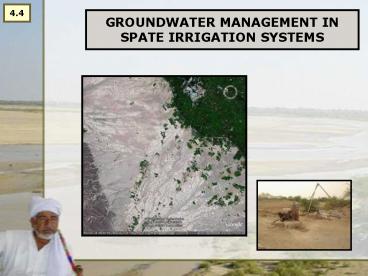GROUNDWATER MANAGEMENT IN SPATE IRRIGATION SYSTEMS - PowerPoint PPT Presentation
1 / 12
Title:
GROUNDWATER MANAGEMENT IN SPATE IRRIGATION SYSTEMS
Description:
because of ingression of saline water. Yet overuse occurs. Statement: Because groundwater is very valuable, need to optimize recharge in spate irrigation areas ... – PowerPoint PPT presentation
Number of Views:96
Avg rating:3.0/5.0
Title: GROUNDWATER MANAGEMENT IN SPATE IRRIGATION SYSTEMS
1
GROUNDWATER MANAGEMENT IN SPATE IRRIGATION SYSTEMS
4.4
2
Ground water use
- Source of drinking water, locally and regionally
- Cultivate high value horticultural crops
3
High value crops For instance Papaya, Mango,
Banana, Vegetables
Especially close to main river bed shallow water
levels are high
4
Yet overuse occurs
Banana plantation (Yemen) failed because of
ingression of saline water
5
StatementBecause groundwater is very valuable,
need to optimize recharge in spate irrigation
areas
6
How to optimize recharge from spate flows?
- Recharge mainly from main riverbed far less
from main wadi flood channels or fields - Recharge most effective from gravelly sections of
the river bed - Recharge most effective, if spate flows slow
- Recharge from flat sections of the river bed
- Recharge from water ponded at bunds and weirs
- Recharge from (subsurface) base flow
- Spread spate over large area to optimize recharge
7
What to do to optimize recharge from spate flows?
- Keep rough gravel bed intact with floods flow (
more roughness bed) be careful not to remove too
much gravel - Consider low weirs/ bed stabilizers to slow down
the flow - Avoid excessive siltation in main recharge
section of the river bed - Do not block the subsurface flow through cut-off
weirs or bed stabilizers!!
8
Not a good idea
Wadi Siham weir in Yemen completely blocked
subsurface flow and caused a dramatic drop in
water levels in downstream wells
9
Not a good idea
The same happened with this bed-stabilizer it
blocked the subsurface flow causing the
recharge of downstream wells to stop
10
Good idea
Farmers in this downstream area argued for a
change in the traditional water distribution
with more chance of a flood going downstream
It was no so much the irrigation from the spate
they were looking instead they were interested
in having their wells recharged
11
Good idea
LOW RECHARGE WEIR TO SLOW DOWN AND SPREAD FLOODS
12
(No Transcript)































